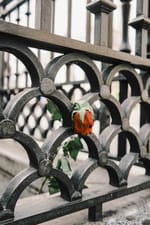I know, I know, another post on Fujifilm JPEG recipes? Who needs that, right? Just leave that type of work to experts like Fuji X Weekly who are able to do the work and be consistent and thorough about it. Nevertheless, I think the way I approach it isn’t mentioned often and therefore might still provide some value. And if that’s not the case, at least I have this post as a reminder for myself on what my current process looks like.1 Okay so here it goes and I’ll try to be brief about it.
I only use two film simulations on my Fujifilm cameras: Classic Chrome and Acros+R for color and black & white shots respectively. I use heavily modified variations of Fuji X Weekly recipes for both. So much so, that I can’t really say that they are from that website anymore but rather the result of my own experimenting. I did start any of these experiments with the JPEG recipes Ritchie2 created though. Credit where it’s due.
Here’s my Classic Chrome setup:
Dynamic Range: DR400Highlights: -2
Shadows: -2
Color: -1
Noise Reduction: -4
Sharpening: +1
Clarity: 0
Grain Effect: off
Color Chrome Effect: Strong
Color Chrome Effect Blue: Weak
White Balance: Daylight, +2 Red & -4 Blue
ISO: anything from ISO 640 and up
As you can see, I do a few things differently than Ritchie. The biggest difference, is that I’m not looking for a nearly finished picture inside the camera. I always edit my photos, even my JPEGs, in Lightroom anyway. Instead, I am looking for the best base picture to apply my edits on. That is why I try to keep my photos inside the camera as flat as possible by using DR400 at all times (meaning I don’t go below ISO 6403) and both highlights and shadows at minus 2. This gives me an JPEG that has all the dynamic range it can get, which I then use to add contrast et al. in Lightroom.
My reasoning behind this, is that while I have the option to boost the contrast and shadows or overexpose the highlights a little in post when shooting this way, I can’t do this the other way around. Once you have added in the heavy shadows or slightly blown out highlights in the JPEG, that data is now baked in and is way harder to manipulate in post. I tried getting a near-finished photo in camera for a while but always ended up with images that are either too contrasty or didn’t have sufficient information in the highlights. My current approach is very similar to the way you might shoot video in a flat picture profile to allow for maximum flexibility in post-production.
This is also why I don’t add grain inside the camera but save that for the edit later. Adding grain is way easier (if not impossible) than removing it again. Instead, I do keep Noise Reduction down to a minimum as much as possible, to still give the images that little bit of structure at higher ISOs that I enjoy very much. I keep clarity off as I don’t like the way it slows down my camera and just add that in post as well.
My approach is practically the same for my black and white photos based on Acros+R:
Dynamic Range: DR400
Highlights: -2
Shadows: -3
Noise Reduction: -4
Sharpening: +1
Clarity: 0
Grain Effect: off
Color Chrome Effect: Strong
Color Chrome Effect Blue: Strong
White Balance: Daylight, +2 Red & -4 Blue
ISO: anything from ISO 640 and up
The biggest difference is that I have shadows set to +3, because I enjoy a good contrasty black and white photo. In color I might shy away from deep blacks but once that is taken out of the equation, I go all the way on the contrast. I might as well grab that in camera then anyway. This is also the reason why I keep both Color Chrome effects at their max strength — it adds that little touch of darkness to the lighter parts the images.
You’ll also see that I don’t shoot with auto ISO but rather set that parameter myself, depending on the amount of light available. In fact, I shoot in full manual and therefore don’t need the exposure compensation dial at all. I do try to overexpose about 1/3 or 2/3 of a stop but only when the scene allows for it. I’ll preserve the highlights whenever I can!
Of course I could just shoot RAW, if my ultimate goal is to have flexibility in post but then I’d loose the speed of working with smaller JPEG files (my computer is starting to show its age) and the — objectively better — color-science that Fujifilm use in their cameras. Sure, I might grab a RAW file when I encounter a scene that is particularly high in contrast and the Adobe versions of Fuji’s film simulations are close enough then.4 Shooting JPEG also allows me to transfer a picture to my phone every now and then when I need it, an option I sometimes missed when I was still a RAW-only boy.
So there you have it, my approach to shooting JPEGs in camera with my film simulation recipes disclosed in full as well. Shall I do another write up on how I edit my JPEGs? That might complete the dissection, wouldn’t it? We’ll see if that happens but if it happens, you’ll find it linked right here.


